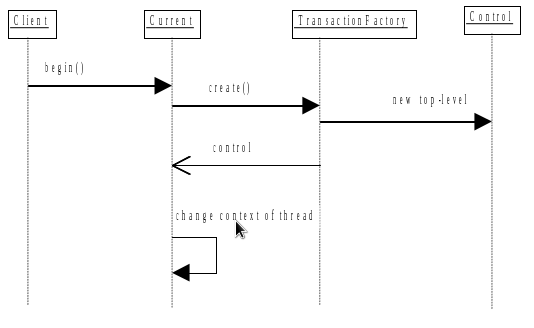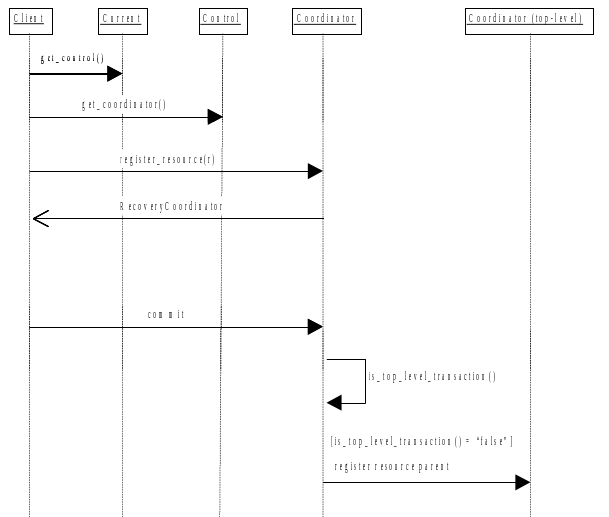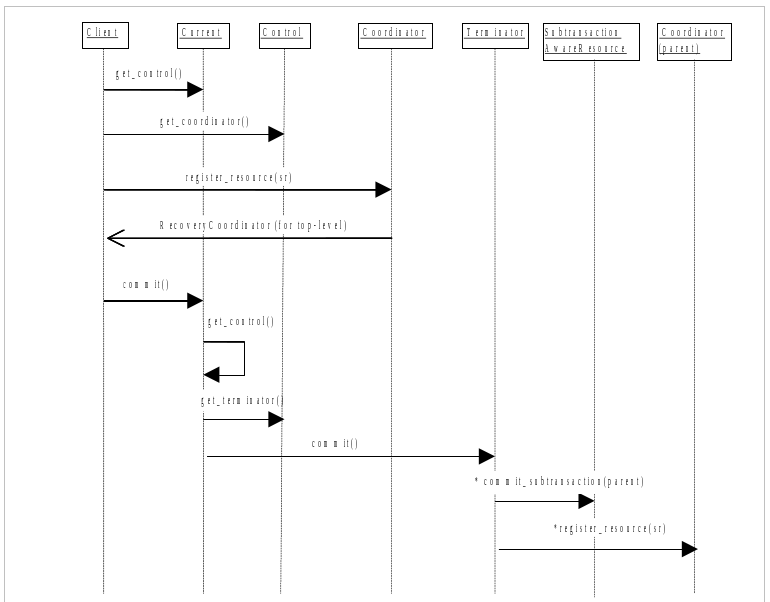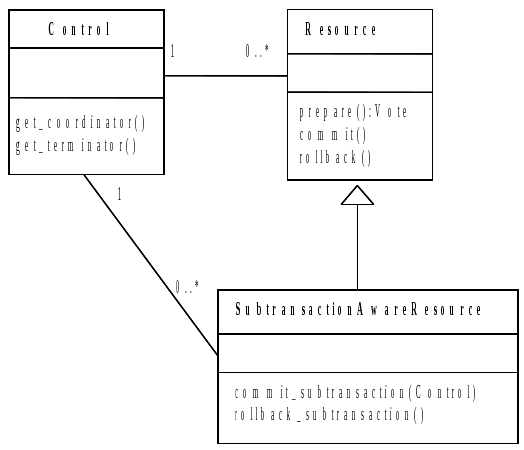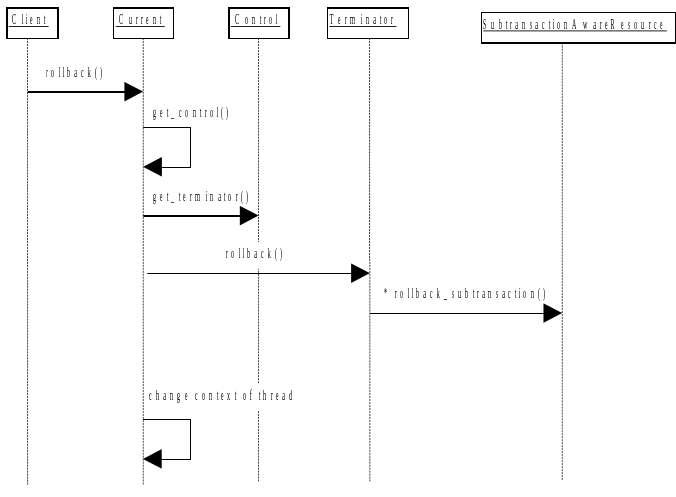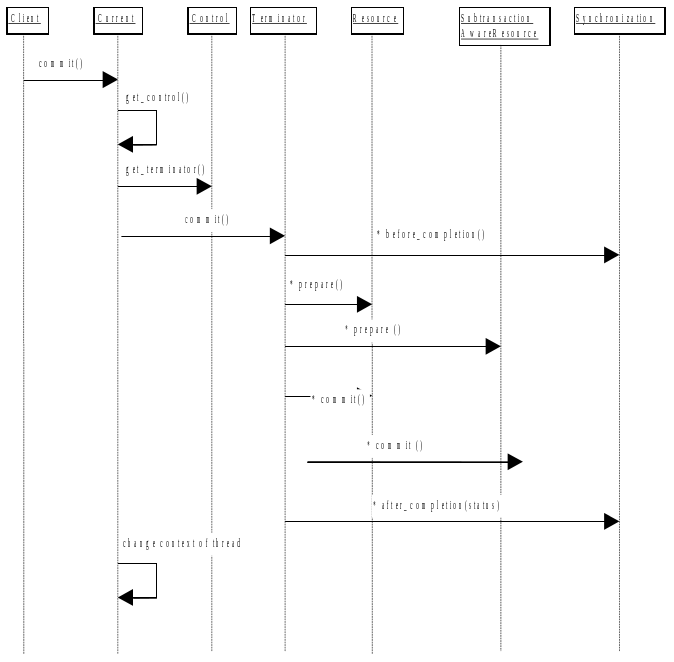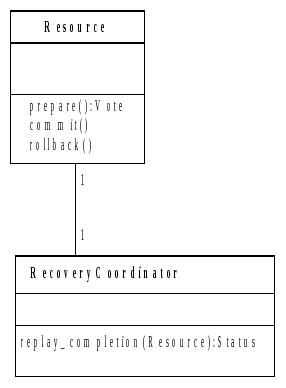- 3.1. Defining the OTS
- 3.2. Action programming models
- 3.3. Interfaces
- 3.4. Transaction factory
- 3.5. Transaction timeouts
- 3.6. Transaction contexts
- 3.7. Transaction controls
- 3.8. The Terminator interface
- 3.9. The Coordinator interface
- 3.10. Heuristics
- 3.11. Current
- 3.12. Resource
- 3.13. SubtransactionAwareResource
- 3.14. The Synchronization interface
- 3.15. Transactions and registered resources
- 3.16. The TransactionalObject interface
- 3.17. Interposition
- 3.18. RecoveryCoordinator
- 3.19. Checked transaction behavior
- 3.20. Summary of JBossTS implementation decisions
Basic JBossTS programming involves using the OTS interfaces provided in the CosTransactions
module, which is specified in CosTransactions.idl. This chapter is based on the OTS
Specification1, specifically with the aspects of OTS that are valuable for developing OTS applications
using JBossTS. Where relevant, each section describes JBossTS implementation decisions and runtime choices available
to you. These choices are also summarized at the end of this chapter. Subsequent chapters illustrate using these
interfaces to construct transactional applications.
The raw CosTransactions interfaces reside in package
org.omg.CosTransactions. The JBossTS implementations of these interfaces reside in package
com.arjuna.CosTransactions and its sub-packages.
You can override many run-time decisions of JBossTS Java properties specified at run-time. The property names are
mentioned in the com.arjuna.ats.jts.common.Environment class.
A client application program can manage a transaction using direct or indirect context management.
Indirect context management means that an application uses the pseudo-object
Current, provided by the Transaction Service, to associate the transaction context with the application thread of control.For direct context management, an application manipulates the
Controlobject and the other objects associated with the transaction.
An object may require transactions to be either explicitly or implicitly propagated to its operations.
Explicit propagation means that an application propagates a transaction context by passing objects defined by the Transaction Service as explicit parameters. Typically the object is the
PropagationContextstructure.Implicit propagation means that requests are implicitly associated with the client’s transaction, by sharing the client's transaction context. The context is transmitted to the objects without direct client intervention. Implicit propagation depends on indirect context management, since it propagates the transaction context associated with the
Currentpseudo-object. An object that supports implicit propagation should not receive any Transaction Service object as an explicit parameter.
A client may use one or both forms of context management, and may communicate with objects that use either method of transaction propagation. This results in four ways in which client applications may communicate with transactional objects:
- Direct Context Management/Explicit Propagation
The client application directly accesses the
Controlobject, and the other objects which describe the state of the transaction. To propagate the transaction to an object, the client must include the appropriate Transaction Service object as an explicit parameter of an operation. Typically, the object is thePropagationContextstructure.- Indirect Context Management/Implicit Propagation
The client application uses operations on the
Currentpseudo-object to create and control its transactions. When it issues requests on transactional objects, the transaction context associated with the current thread is implicitly propagated to the object.- Indirect Context Management/Explicit Propagation
for an implicit model application to use explicit propagation, it can get access to the Control using the get_control operation on the Current pseudo object. It can then use a Transaction Service object as an explicit parameter to a transactional object; for efficiency reasons this should be the PropagationContext structure, obtained by calling get_txcontext on the appropriate Coordinator reference. This is explicit propagation.
- Direct Context Management/Implicit Propagation
A client that accesses the Transaction Service objects directly can use the
resumepseudo-object operation to set the implicit transaction context associated with its thread. This way, the client can invoke operations of an object that requires implicit propagation of the transaction context.
The main difference between direct and indirect context management is the effect on the invoking thread’s
transaction context. Indirect context management causes the thread’s transaction context to be modified
automatically by the OTS. For instance, if method begin is called, the thread’s notion of
the current transaction is modified to the newly-created transaction. When the transaction is terminated, the
transaction previously associated with the thread, if one existed, is restored as the thread’s context. This
assumes that subtransactions are supported by the OTS implementation.
If you use direct management, no changes to the thread's transaction context are made by the OTS, leaving the responsibility to you.
Table 3.1. Interfaces
| Function | Used by | Direct context mgmt | Indirect context mgmt |
|---|---|---|---|
Create a transaction | Transaction originator | Factory::create
| begin set_timeout |
| Terminate a transaction | Transaction originator (implicit) All (explicit) |
| commit rollback |
| Rollback transaction | Server |
|
|
| Propagation of transaction to server | Server | Declaration of method parameter |
|
| Client control of transaction propagation to server | All | Request parameters |
|
| Register with a transaction | Recoverable Server |
| N/A |
| Miscellaneous | All |
| N/A |
Note
For clarity, subtransaction operations are not shown
The TransactionFactory interface allows the transaction originator to begin a
top-level transaction. Subtransactions must be created using the begin method of
Current, or the create_subtransaction method of the parent’s
Coordinator.) Operations on the factory and Coordinator to create new transactions use
direct context management, and therefore do not modify the calling thread’s transaction context.
The create operation creates a new top-level transaction and returns its
Control object, which you can use to manage or control participation in the new
transaction. Method create takes a parameter that is is an application-specific timeout
value, in seconds. If the transaction does not complete before this timeout elapses, it is rolled back. If the
parameter is 0, no application-specific timeout is established.
Note
Subtransactions do not have a timeout associated with them.
The Transaction Service implementation allows the TransactionFactory to be a separate
server from the application, shared by transactions clients, and which manages transactions on their
behalf. However, the specification also allows the TransactionFactory to be implemented by an object within each
transactional client. This is the default implementation used by JBossTS, because it removes the need for a
separate service to be available in order for transactional applications to execute, and therefore reduces a point
of failure.
If your applications require a separate transaction manager, set the OTS_TRANSACTION_MANAGER
environment variable to the value YES. The system locates the transaction manager server in a
manner specific to the ORB being used. The server can be located in a number of ways.
Registration with a name server.
Addition to the ORB’s initial references, using a JBossTS specific references file.
The ORB’s specific location mechanism, if applicable.
Similar to the resolve_initial_references, JBossTS supports an initial reference file
where you can store references for specific services, and use these references at runtime. The file,
CosServices.cfg, consists of two columns, separated by a single space.
The service name, which is
TransactionServicein the case of the OTS server.The IOR
CosServices.cfg is usually located in the etc/ directory of the
JBossTS installation. The OTS server automatically registers itself in this file, creating it if necessary, if
you use the configuration file mechanism. Stale information is also automatically removed. The Transaction
Service locates CosServices.cfg at runtime, using the
OrbPortabilityEnvironmentBean properties initialReferencesRoot and
InitialReferencesFile. initialReferencesRoot names a directory, and
defaults to the current working directory. initialReferencesFile refers to a file within the
initialReferencesRoot, and defaults to the name CosServices.cfg.
If your ORB supports a name service, and you configure JBossTS to use it, the transaction manager is automatically registered with it.
You can override the default location mechanism with the RESOLVE_SERVICE property variable,
which can have any of three possible values.
| CONFIGURATION_FILE | This is the default option, and directs the system to use the
|
| NAME_SERVICE | JBossTS tries to use a name service to locate the transaction factory. If the ORB does not support the name service mechanism, JBossTS throws an exception. |
| BIND_CONNECT | JBossTS uses the ORB-specific bind mechanism. If the ORB does not support such a mechanism, JBossTS throws an exception. |
If RESOLVE_SERVICE is specified when running the transaction factory, the factory registers
itself with the specified resolution mechanism.
As of JBossTS 4.5, transaction timeouts are unified across all transaction components and are controlled by ArjunaCore. Refer to the ArjunaCore Development Guide for more information.
Transaction contexts are fundamental to the OTS architecture. Each thread is associated with a context in one of three ways.
| Null | The thread has no associated transaction. |
| A transaction ID | The thread is associated with a transaction. |
Contexts may be shared across multiple threads. In the presence of nested transactions, a context remembers the
stack of transactions started within the environment, so that the context of the thread can be restored to the
state before the nested transaction started, when the nested transaction ends. Threads most commonly use object
Current to manipulate transactional information, which is represented by
Control objects. Current is the broker between a transaction and
Control objects.
Your application can manage transaction contexts either directly or indirectly. In the direct approach, the
transaction originator issues a request to a TransactionFactory to begin a new top-level
transaction. The factory returns a Control object that enables both a
Terminator interface and a Coordinator
interface. Terminator ends a
transaction. Coordinator associates a thread with a transaction, or begins a nested
transaction. You need to pass each interface as an explicit parameter in invocations of operations, because
creating a transaction with them does not change a thread's current context. If you use the factory, and need to
set the current context for a thread to the context which its control object returns, use the
resume method of interface Current.
Example 3.1. Interfaces Terminator, Coordinator, and
Control
interface Terminator
{
void commit (in boolean report_heuristics) raises (HeuristicMixed, HeuristicHazard);
void rollback ();
};
interface Coordinator
{
Status get_status ();
Status get_parent_status ();
Status get_top_level_status ();
RecoveryCoordinator register_resource (in Resource r) raises (Inactive);
Control create_subtransaction () raises (SubtransactionsUnavailable,
Inactive);
void rollback_only () raises (Inactive);
...
};
interface Control
{
Terminator get_terminator () raises (Unavailable);
Coordinator get_coordinator () raises (Unavailable);
};
interface TransactionFactory
{
Control create (in unsigned long time_out);
};
When the factory creates a transaction, you can specify a timeout value in seconds. If the transaction times out,
it is subject to possible roll-back. Set the timeout to 0 to disable application-specific
timeout.
The Current interface handles implicit context management. Implicit context
management provides simplified transaction management functionality, and automatically creates nested transactions
as required. Transactions created using Current do not alter a thread’s current
transaction context.
Example 3.2. Interface Current
interface Current : CORBA::Current
{
void begin () raises (SubtransactionsUnavailable);
void commit (in boolean report_heuristics) raises (NoTransaction,
HeuristicMixed,
HeuristicHazard);
void rollback () raises (NoTransaction);
void rollback_only () raises (NoTransaction);
. . .
Control get_control ();
Control suspend ();
void resume (in Control which) raises (InvalidControl);
};
Subtransactions are a useful mechanism for two reasons:
- fault-tolerance
If a subtransaction rolls back, the enclosing transaction does not also need to roll back. This preserves as much of the work done so far, as possible.
- modularity
Indirect transaction management does not require special syntax for creating subtransactions. Begin a transaction, and if another transaction is associated with the calling thread, the new transaction is nested within the existing one. If you know that an object requires transactions, you can use them within the object. If the object's methods are invoked without a client transaction, the object's transaction is top-level. Otherwise, it is nested within the client's transaction. A client does not need to know whether an object is transactional.
The outermost transaction of the hierarchy formed by nested transactions is called the top-level transaction. The inner components are called subtransactions. Unlike top-level transactions, the commits of subtransactions depend upon the commit/rollback of the enclosing transactions. Resources acquired within a subtransaction should be inherited by parent transactions when the top-level transaction completes. If a subtransaction rolls back, it can release its resources and undo any changes to its inherited resources.
In the OTS, subtransactions behave differently from top-level transactions at commit time. Top-level transactions undergo a two-phase commit protocol, but nested transactions do not actually perform a commit protocol themselves. When a program commits a nested transaction, it only informs registered resources of its outcome. If a resource cannot commit, an exception is thrown, and the OTS implementation can ignore the exception or roll back the subtransaction. You cannot roll back a subtransaction if any resources have been informed that the transaction committed.
The OTS supports both implicit and explicit propagation of transactional behavior.
Implicit propagation means that an operation signature specifies no transactional behavior, and each invocation automatically sends transaction context associated with the calling thread.
Explicit propagation means that applications must define their own mechanism for propagating transactions. This has the following features:
A client to control if its transaction is propagated with any operation invocation.
A client can invoke operations on both transactional and non-transactional objects within a transaction.
Transaction context management and transaction propagation are different things that may be controlled independently of each other. Mixing of direct and indirect context management with implicit and explicit transaction propagation is supported. Using implicit propagation requires cooperation from the ORB. The client must send current context associated with the thread with any operation invocations, and the server must extract them before calling the targeted operation.
If you need implicit context propagation, ensure that JBossTS is correctly initialized before you create
objects. Both client and server must agree to use implicit propagation. To use implicit context propagation,
your ORB needs to support filters or interceptors, or the CosTSPortability
interface.
| Implicit context propagation | Property variable |
| Interposition | Property variable |
Important
Interposition is required to use the JBossTS Advanced API.
Example 3.3. Simple transactional client using direct context management and explicit transaction propagation
{
...
org.omg.CosTransactions.Control c;
org.omg.CosTransactions.Terminator t;
org.omg.CosTransactions.PropagationContext pgtx;
c = transFact.create(0); // create top-level action
pgtx = c.get_coordinator().get_txcontext();
...
trans_object.operation(arg, pgtx); // explicit propagation
...
t = c.get_terminator(); // get terminator
t.commit(false); // so it can be used to commit
...
}
The next example rewrites the same program to use indirect context management and implicit propagation. This example is considerably simpler, because the application only needs to start and either commit or abort actions.
Example 3.4. Indirect context management and implicit propagation
{
...
current.begin(); // create new action
...
trans_object2.operation(arg); // implicit propagation
...
current.commit(false); // simple commit
...
}
The last example illustrates the flexibility of OTS by using both direct and indirect context management in conjunction with explicit and implicit transaction propagation.
Example 3.5. Direct and direct context management with explicitly and implicit propagation
{
...
org.omg.CosTransactions.Control c;
org.omg.CosTransactions.Terminator t;
org.omg.CosTransactions.PropagationContext pgtx;
c = transFact.create(0); // create top-level action
pgtx = c.get_coordinator().get_txcontext();
current.resume(c); // set implicit context
...
trans_object.operation(arg, pgtx); // explicit propagation
trans_object2.operation(arg); // implicit propagation
...
current.rollback(); // oops! rollback
...
}
The Control interface allows a program to explicitly manage or propagate a
transaction context. An object supporting the Control interface is associated with
one specific transaction. The Control interface supports two operations:
get_terminator and
get_coordinator. get_terminator returns an instance of the
Terminator interface. get_coordinator returns an instance
of the Coordinator interface. Both of these methods throw the
Unavailable exception if the Control cannot provide the
requested object. The OTS implementation can restrict the ability to use the Terminator and Coordinator in other
execution environments or threads. At a minimum, the creator must be able to use them.
Obtain the Control object for a transaction when it is created either by using either the
TransactionFactory or create_subtransaction methods defined by
the Coordinator interface. Obtain a Control for the
transaction associated with the current thread using the get_control or
suspend methods defined by the Current interface.
The transaction creator must be able to use its Control, but the OTS
implementation decides whether other threads can use Control. JBossTS places no
restrictions the users of the Control.
The OTS specification does not provide a means to indicate to the transaction system that information and
objects associated with a given transaction can be purged from the system. In JBossTS, the
Current interface destroys all information about a transaction when it
terminates. For that reason, do not use any Control references to the transaction
after it commits or rolls back.
However, if the transaction is terminated using the Terminator interface, it is up to the programmer to signal that the transaction information is no longer required: this can be done using the destroyControl method of the OTS class in the com.arjuna.CosTransactions package. Once the program has indicated that the transaction information is no longer required, the same restrictions on using Control references apply as described above. If destroyControl is not called then transaction information will persist until garbage collected by the Java runtime.
In JBossTS, you can propagate Coordinators and
Terminators between execution environments.
The Terminator interface supports commit and
rollback operations. Typically, the transaction originator uses these operations. Each
object supporting the Terminator interface is associated with a single transaction. Direct context management via
the Terminator interface does not change the client thread’s notion of the current transaction.
The commit operation attempts to commit the transaction. To successfully commit, the
transaction must not be marked rollback only, and all of its must participants agree to
commit. Otherwise, the TRANSACTION_ROLLEDBACK exception is thrown. If the
report_heuristics parameter is true, the Transaction Service reports
inconsistent results using the HeuristicMixed and
HeuristicHazard exceptions.
When a transaction is committed, the coordinator drives any registered Resources using
their prepare or commit methods. These Resources are responsible
to ensure that any state changes to recoverable objects are made permanent, to guarantee the ACID properties.
When rollback is called, the registered Resources need to
guarantee that all changes to recoverable objects made within the scope of the transaction, and its descendants,
is undone. All resources locked by the transaction are made available to other transactions, as appropriate to the
degree of isolation the resources enforce.
See Section 3.7.1, “JBossTS specifics” for how long Terminator
references remain valid after a transaction terminates.
When a transaction is committing, it must make certain state changes persistent, so that it can recover if a
failure occurs, and continue to commit, or rollback. To guarantee ACID properties, flush these state changes to
the persistence store implementation before the transaction proceeds to commit. Otherwise, the application may
assume that the transaction has committed, when the state changes may still volatile storage, and may be lost by
a subsequent hardware failure. By default, JBossTS makes sure that such state changes are flushed. However,
these flushes can impose a significant performance penalty to the application. To prevent transaction state
flushes, set the TRANSACTION_SYNC variable to OFF. Obviously, do this at
your own risk.
When a transaction commits, if only a single resource is registered, the transaction manager does not need to
perform the two-phase protocol. A single phase commit is possible, and the outcome of the transaction is
determined by the resource. In a distributed environment, this optimization represents a significant performance
improvement. As such, JBossTS defaults to performing single phase commit in this situation. Override this
behavior at runtime by setting the COMMIT_ONE_PHASE property variable to
NO.
The Coordinator interface is returned by the get_coordinator method of the
Control interface. It supports the operations resources need to participate in a
transaction. These participants are usually either recoverable objects or agents of recoverable objects, such as
subordinate coordinators. Each object supporting the Coordinator interface is
associated with a single transaction. Direct context management via the Coordinator interface does not change the
client thread’s notion of the current transaction. You can terminate transaction directly, through the
Terminator interface. In that case, trying to terminate the transaction a second
time using Current causes an exception to be thrown for the second termination
attempt.
The operations supported by the Coordinator interface of interest to application programmers are:
Table 3.2. Operations supported by the Coordinator interface
|
|
Return the status of the associated transaction. At any given time a transaction can have one of the following status values representing its progress:
|
|
|
You can use these operations for transaction comparison. Resources may use these various operations to guarantee that they are registered only once with a specific transaction. |
|
|
Returns a hash code for the specified transaction. |
|
|
Registers the specified Resource as a participant in the transaction. The
|
| register_subtran_aware |
Registers the specified subtransaction-aware resource with the current transaction, so that it know when
the subtransaction commits or rolls back. This method cannot register the resource as a participant in
the top-level transaction. The |
| register_synchronization |
Registers the |
| rollback_only |
Marks the transaction so that the only possible outcome is for it to rollback. The Inactive exception is raised if the transaction has already been prepared/completed. |
| create_subtransaction |
A new subtransaction is created. Its parent is the current transaction. The
|
See Section 3.7.1, “JBossTS specifics” to control how long Coordinator
references remain valid after a transaction terminates.
Note
To disable subtransactions, set set the OTS_SUPPORT_SUBTRANSACTIONS property variable to
NO.
The OTS permits individual resources to make heuristic decisions. Heuristic decisions are unilateral decisions made by one or more participants to commit or abort the transaction, without waiting for the consensus decision from the transaction service. Use heuristic decisions with care and only in exceptional circumstances, because they can lead to a loss of integrity in the system. If a participant makes a heuristic decision, an appropriate exception is raised during commit or abort processing.
Table 3.3. Possible heuristic outcomes
| HeuristicRollback |
Raised on an attempt to commit, to indicate that the resource already unilaterally rolled back the transaction. |
| HeuristicCommit |
Raised on an attempt to roll back, to indicate that the resource already unilaterally committed the transaction. |
| HeuristicMixed |
Indicates that a heuristic decision has been made. Some updates committed while others rolled back. |
| HeuristicHazard |
Indicates that a heuristic decision may have been made, and the outcome of some of the updates is unknown. For those updates which are known, they either all committed or all rolled back. |
HeuristicMixed takes priority over HeuristicHazard. Heuristic decisions are only reported back to the originator
if the report_heuristics argument is set to true when you invoke the
commit operation.
The Current interface defines operations that allow a client to explicitly manage
the association between threads and transactions, using indirect context management. It defines operations that
simplify the use of the Transaction Service.
Table 3.4. Methods of Current
| begin |
Creates a new transaction and associates it with the current thread. If the client thread is currently
associated with a transaction, and the OTS implementation supported nested transactions, the new
transaction becomes a subtransaction of that transaction. Otherwise, the new transaction is a top-level
transaction. If the OTS implementation does not support nested transactions, the
|
| commit |
Commits the transaction. If the client thread does not have permission to commit the transaction, the
standard exception |
| rollback |
Rolls back the transaction. If the client thread does not have permission to terminate the transaction,
the standard exception |
| rollback_only |
Limits the transaction's outcome to rollback only. If the transaction has already been terminated, or is in the process of terminating, an appropriate exception is thrown. |
| get_status |
Returns the status of the current transaction, or exception |
| set_timeout |
Modifies the timeout associated with top-level transactions for subsequent
|
| get_control |
Obtains a |
| suspend |
Obtains an object representing a transaction's context. If the client thread is not associated with a
transaction, a null object reference is returned. You can pass this object to the
|
| resume |
Associates the client thread with a transaction. If the parameter is a null object reference, the client thread becomes associated with no transaction. The thread loses association with any previous transactions. |
Ideally, you should Obtain Current by using the life-cycle service factory
finder. However, very few ORBs support this. JBossTS provides method get_current of
Current for this purpose. This class hides any ORB-specific mechanisms required
for obtaining Current.
If no timeout value is associated with Current, JBossTS associates no timeout
with the transaction. The current OTS specification does not provide a means whereby the timeout associated with
transaction creation can be obtained. However, JBossTS Current supports a get_timeout method.
By default, the JBossTS implementation of Current does not use a separate
TransactionFactory server when creating new top-level transactions. Each transactional
client has a TransactionFactory co-located with it. Override this by setting the
OTS_TRANSACTION_MANAGER variable to YES.
The transaction factory is located in the bin/ directory of the JBossTS distribution. Start
it by executing the OTS script. Current locates the factory
in a manner specific to the ORB: using the name service, through
resolve_initial_references, or via the CosServices.cfg file. The
CosServices.cfg file is similar to resolve_initial_references, and
is automatically updated when the transaction factory is started on a particular machine. Copy the file to each
JBossTS instance which needs to share the same transaction factory.
If you do not need subtransaction support, set the OTS_SUPPORT_SUBTRANSACTIONS property
variable to NO. The setCheckedAction method overrides the
CheckedAction implementation associated with each transaction created by the
thread.
The Transaction Service uses a two-phase commit protocol to complete a top-level transaction with each registered resource.
Example 3.6. Completing a top-level transaction
interface Resource
{
Vote prepare ();
void rollback () raises (HeuristicCommit, HeuristicMixed,
HeuristicHazard);
void commit () raises (NotPrepared, HeuristicRollback,
HeuristicMixed, HeuristicHazard);
void commit_one_phase () raises (HeuristicRollback, HeuristicMixed,
HeuristicHazard);
void forget ();
};
The Resource interface defines the operations invoked by the transaction
service. Each Resource object is implicitly associated with a single top-level
transaction. Do not register a Resource with the same transaction more than
once. When you tell a Resource to prepare, commit, or abort, it must do so on
behalf of a specific transaction. However, the Resource methods do not specify the
transaction identity. It is implicit, since a Resource can only be registered with
a single transaction.
Transactional objects must use the register_resource method to register objects
supporting the Resource interface with the current transaction. An object
supporting the Coordinator interface is either passed as a parameter in the case of
explicit propagation, or retrieved using operations on the Current interface in the
case of implicit propagation. If the transaction is nested, the Resource is not
informed of the subtransaction’s completion, and is registered with its parent upon commit.
This example assumes that transactions are only nested two levels deep, for simplicity.
Do not register a given Resource with the same transaction more than once, or it
will receive multiple termination calls. When a Resource is directed to prepare,
commit, or abort, it needs to link these actions to a specific transaction. Because
Resource methods do not specify the transaction identity, but can only be associated with a
single transaction, you can infer the identity.
A single Resource or group of Resources guarantees
the ACID properties for the recoverable object they represent. A Resource's work depends on the phase of its
transaction.
- prepare
If none of the persistent data associated with the resource is modified by the transaction, the Resource can return
VoteReadOnlyand forget about the transaction. It does not need to know the outcome of the second phase of the commit protocol, since it hasn't made any changes.If the resource can write, or has already written, all the data needed to commit the transaction to stable storage, as well as an indication that it has prepared the transaction, it can return
VoteCommit. After receiving this response, the Transaction Service either commits or rolls back. To support recovery, the resource should store theRecoveryCoordinatorreference in stable storage.The resource can return
VoteRollbackunder any circumstances. After returning this response, the resource can forget the transaction.The
Resourcereports inconsistent outcomes using theHeuristicMixedandHeuristicHazardexceptions. One example is that aResourcereports that it can commit and later decides to roll back. Heuristic decisions must be made persistent and remembered by theResourceuntil the transaction coordinator issues theforgetmethod. This method tells theResourcethat the heuristic decision has been noted, and possibly resolved.- rollback
The resource should undo any changes made as part of the transaction. Heuristic exceptions can be used to report heuristic decisions related to the resource. If a heuristic exception is raised, the resource must remember this outcome until the forget operation is performed so that it can return the same outcome in case rollback is performed again. Otherwise, the resource can forget the transaction.
- commit
If necessary, the resource should commit all changes made as part of this transaction. As with
rollback, it can raise heuristic exceptions. TheNotPreparedexception is raised if the resource has not been prepared.- commit_one_phase
Since there can be only a single resource, the
HeuristicHazardexception reports heuristic decisions related to that resource.- forget
Performed after the resource raises a heuristic exception. After the coordinator determines that the heuristic situation is addressed, it issues
forgeton the resource. The resource can forget all knowledge of the transaction.
Recoverable objects that need to participate within a nested transaction may support the
SubtransactionAwareResource interface, a specialization of the
Resource interface.
Example 3.7. Interface SubtransactionAwareResource
interface SubtransactionAwareResource : Resource
{
void commit_subtransaction (in Coordinator parent);
void rollback_subtransaction ();
};
A recoverable object is only informed of the completion of a nested transaction if it registers a
SubtransactionAwareResource. Register the object with either the
register_resource of the Coordinator interface, or the
register_subtran_aware method of the Current interface. A
recoverable object registers Resources to participate within the completion of top-level transactions, and
SubtransactionAwareResources keep track of the completion of subtransactions. The
commit_subtransaction method uses a reference to the parent transaction to allow
subtransaction resources to register with these transactions.
SubtransactionAwareResources find out about the completion of a transaction after it terminates. They cannot affect the outcome of the transaction. Different OTS implementations deal with exceptions raised by SubtransactionAwareResources in implementation-specific ways.
Use method register_resource or method register_subtran_aware to
register a SubtransactionAwareResource with a transaction using.
- register_resource
If the transaction is a subtransaction, the resource is informed of its completion, and automatically registered with the subtransaction’s parent if the parent commits.
- register_subtran_aware
If the transaction is not a subtransaction, an exception is thrown. Otherwise, the resource is informed when the subtransaction completes. Unlike
register_resource, the resource is not propagated to the subtransaction’s parent if the transaction commits. If you need this propagation, re-register using the supplied parent parameter.
In either case, the resource cannot affect the outcome of the transaction completion. It can only act on the transaction's decision, after the decision is made. However, if the resource cannot respond appropriately, it can raise an exception. Thee OTS handles these exceptions in an implementation-specific way.
A SubtransactionAwareResource which raises an exception to the commitment of a
transaction may create inconsistencies within the transaction if other
SubtransactionAwareResources think the transaction committed. To prevent this possibility
of inconsistency, JBossTS forces the enclosing transaction to abort if an exception is raised.
JBossTS also provides extended subtransaction aware resources to overcome this, and other problems. See Section for further details.
If an object needs notification before a transaction commits, it can register an object which is an implements the
Synchronization interface, using the
register_synchronization operation of the Coordinator
interface. Synchronizations flush volatile state data to a recoverable object or database before the transaction
commits. You can only associate Synchronizations with top-level transactions. If you try to associate a
Synchronization to a nested transaction, an exception is thrown. Each object supporting the
Synchronization interface is associated with a single top-level transaction.
Example 3.8. Synchronization
interface Synchronization : TransactionalObject
{
void before_completion ();
void after_completion (in Status s);
};
The method before_completion is called before the two-phase commit protocol starts, and
after_completion is called after the protocol completes. The final status of the
transaction is given as a parameter to after_completion. If
before_completion raises an exception, the transaction rolls back. Any exceptions thrown
by after_completion do not affect the transaction outcome.
The OTS only requires Synchronizations to be invoked if the transaction commits. If it rolls back, registered Synchronizations are not informed.
Given the previous description of Control, Resource,
SubtransactionAwareResource, and Synchronization, the following UML relationship
diagram can be drawn:
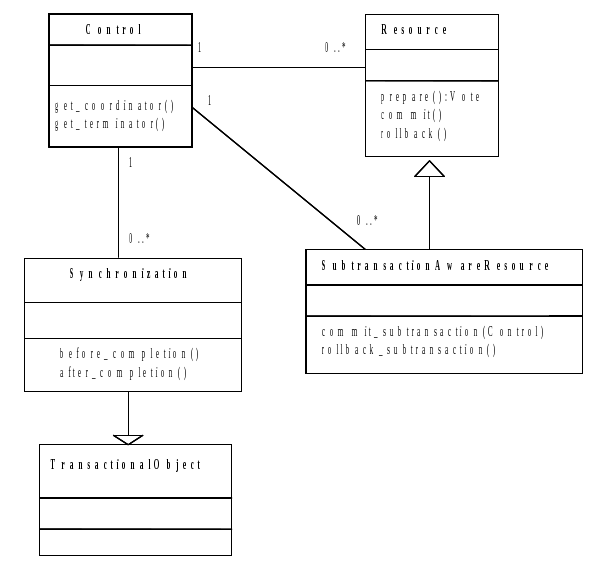
[D]
Figure 3.7. Relationship between Control, Resource, SubtransactionAwareResource, and Synchronization
Synchronizations must be called before the top-level transaction commit protocol starts, and after it
completes. By default, if the transaction is instructed to roll back, the Synchronizations associated with the
transaction is not contacted. To override this, and call Synchronizations regardless of the transaction's
outcome, set the OTS_SUPPORT_ROLLBACK_SYNC property variable to YES.
If you use distributed transactions and interposition, a local proxy for the top-level transaction coordinator
is created for any recipient of the transaction context. The proxy looks like a Resource
or SubtransactionAwareResource, and registers itself as such with the actual top-level
transaction coordinator. The local recipient uses it to register Resources and
Synchronizations locally.
The local proxy can affect how Synchronizations are invoked during top-level transaction commit. Without the
proxy, all Synchronizations are invoked before any Resource or SubtransactionAwareResource objects are
processed. However, with interposition, only those Synchronizations registered locally to the transaction
coordinator are called. Synchronizations registered with remote participants are only called when the interposed
proxy is invoked. The local proxy may only be invoked after locally-registered Resource or
SubtransactionAwareResource objects are invoked. With the
OTS_SUPPORT_INTERPOSED_SYNCHRONIZATION property variable set to YES, all
Synchronizations are invoked before any Resource or SubtransactionAwareResource, no matter where they are
registered.
In Figure 3.9, “Subtransaction commit”, a subtransaction with both Resource and
SubtransactionAwareResource objects commits. The
SubtransactionAwareResources were registered using
register_subtran_aware. The Resources do not know the
subtransaction terminated, but the SubtransactionAwareResources do. Only the
Resources are automatically propagated to the parent transaction.
Figure 3.10, “Subtransaction rollback” illustrates the impact of a subtransaction rolling back. Any registered
resources are discarded, and all SubtransactionAwareResources are informed of the
transaction outcome.
Figure 3.11, “Top-level commit” shows the activity diagram for committing a top-level
transaction. Subtransactions within the top-level transaction which have also successfully committed propagate
SubtransactionAwareResources to the top-level transaction. These
SubtransactionAwareResources then participate within the two-phase commit protocol. Any
registered Synchronizations are contacted before prepare is
called. Because of indirect context management, when the transaction commits, the transaction service changes the
invoking thread’s transaction context.
The TransactionalObject interface indicates to an object that it is
transactional. By supporting this interface, an object indicates that it wants to associate the transaction
context associated with the client thread with all operations on its interface. The
TransactionalObject interface defines no operations.
OTS specifications do not require an OTS to initialize the transaction context of every request handler. It is
only a requirement if the interface supported by the target object is derived from
TransactionalObject. Otherwise, the initial transaction context of the thread is
undefined. A transaction service implementation can raise the TRANSACTION_REQUIRED
exception if a TransactionalObject is invoked outside the scope of a transaction.
In a single-address space application, transaction contexts are implicitly shared between clients and objects,
regardless of whether or not the objects support the TransactionalObject
interface. To preserve distribution transparency, where implicit transaction propagation is supported, you can
direct JBossTS to always propagate transaction contexts to objects. The default is only to propagate if the object
is a TransactionalObject. Set the OTS_ALWAYS_PROPAGATE_CONTEXT
property variable to NO to override this behavior.
By default, JBossTS does not require objects which support the TransactionalObject
interface to invoked within the scope of a transaction. The object determines whether it should be invoked within
a transaction. If so, it must throw the TransactionRequired exception. Override this
default by setting the OTS_NEED_TRAN_CONTEXT shell environment variable to
YES.
Important
Make sure that the settings for OTS_ALWAYS_PROPAGATE_CONTEXT and
OTS_NEED_TRAN_CONTEXT are identical at the client and the server. If they are not identical
at both ends, your application may terminate abnormally.
OTS objects supporting interfaces such as the Control interface are standard CORBA
objects. When an interface is passed as a parameter in an operation call to a remote server, only an object
reference is passed. This ensures that any operations that the remote server performs on the interface are
correctly performed on the real object. However, this can have substantial penalties for the application, because
of the overhead of remote invocation. For example, when the server registers a Resource
with the current transaction, the invocation might be remote to the originator of the transaction.
To avoid this overhead, your OTS may support interposition. This permits a server to create a local control object which acts as a local coordinator, and fields registration requests that would normally be passed back to the originator. This coordinator must register itself with the original coordinator, so that it can correctly participate in the commit protocol. Interposed coordinators form a tree structure with their parent coordinators.
To use interposition, ensure that JBossTS is correctly initialized before creating objects. Also, the client and
server must both use interposition. Your ORB must support filters or interceptors, or the
CosTSPortability interface, since interposition requires the use of implicit
transaction propagation. To use interposition, set the OTS_CONTEXT_PROP_MODE property variable
to INTERPOSITION.
Note
Interposition is not required if you use the JBossTS advanced API.
A reference to a RecoveryCoordinator is returned as a result of successfully calling
register_resource on the transaction's Coordinator. Each
RecoveryCoordinator is implicitly associated with a single
Resource. It can drive the Resource through recovery procedures in
the event of a failure which occurs during the transaction.
The OTS supports both checked and unchecked transaction behavior.
Integrity constraints of checked transactions
A transaction will not commit until all transactional objects involved in the transaction have completed their transactional requests.
Only the transaction originator can commit the transaction
Checked transactional behavior is typical transaction behavior, and is widely implemented. Checked behavior requires implicit propagation, because explicit propagation prevents the OTS from tracking which objects are involved in the transaction.
Unchecked behavior allows you to implement relaxed models of atomicity. Any use of explicit propagation implies
the possibility of unchecked behavior, since you as the programmer are in control of the behavior. Even if you use
implicit propagation, a server may unilaterally abort or commit the transaction using the
Current interface, causing unchecked behavior.
Some OTS implementations enforce checked behavior for the transactions they support, to provide an extra level of transaction integrity. The checks ensure that all transactional requests made by the application complete their processing before the transaction is committed. A checked Transaction Service guarantees that commit fails unless all transactional objects involved in the transaction complete the processing of their transactional requests. Rolling back the transaction does not require such as check, since all outstanding transactional activities will eventually roll back if they are not directed to commit.
There are many possible implementations of checking in a Transaction Service. One provides equivalent function to that provided by the request and response inter-process communication models defined by X/Open. The X/Open Transaction Service model of checking widely implemented. It describes the transaction integrity guarantees provided by many existing transaction systems. These transaction systems provide the same level of transaction integrity for object-based applications, by providing a Transaction Service interface that implements the X/Open checks.
In X/Open, completion of the processing of a request means that the object has completed execution of its method and replied to the request. The level of transaction integrity provided by a Transaction Service implementing the X/Open model provides equivalent function to that provided by the XATMI and TxRPC interfaces defined by X/Open for transactional applications. X/Open DTP Transaction Managers are examples of transaction management functions that implement checked transaction behavior.
This implementation of checked behavior depends on implicit transaction propagation. When implicit propagation is used, the objects involved in a transaction at any given time form a tree, called the request tree for the transaction. The beginner of the transaction is the root of the tree. Requests add nodes to the tree, and replies remove the replying node from the tree. Synchronous requests, or the checks described below for deferred synchronous requests, ensure that the tree collapses to a single node before commit is issued.
If a transaction uses explicit propagation, the Transaction Service has no way to know which objects are or will be involved in the transaction. Therefore, the use of explicit propagation is not permitted by a Transaction Service implementation that enforces X/Open-style checked behavior.
Applications that use synchronous requests exhibit checked behavior. If your application uses deferred synchronous
requests, all clients and objects need to be under the control of a checking Transaction Service. In that case,
the Transaction Service can enforce checked behavior, by applying a reply check and a
committed check. The Transaction Service must also apply a
resume check, so that the transaction is only resumed by applications in the correct part
of the request tree.
| reply check |
Before an object replies to a transactional request, a check is made to ensure that the object has received replies to all the deferred synchronous requests that propagated the transaction in the original request. If this condition is not met, an exception is raised and the transaction is marked as rollback-only. A Transaction Service may check that a reply is issued within the context of the transaction associated with the request. |
| commit check |
Before a commit can proceed, a check is made to ensure that the commit request for the transaction is being issued from the same execution environment that created the transaction, and that the client issuing commit has received replies to all the deferred synchronous requests it made that propagated the transaction. |
| resume check |
Before a client or object associates a transaction context with its thread of control, a check is made to ensure that this transaction context was previously associated with the execution environment of the thread. This association would exist if the thread either created the transaction or received it in a transactional operation. |
Where support from the ORB is available, JBossTS supports X/Open checked transaction behavior. However, unless
the OTS_CHECKED_TRANSACTIONS property variable is set to YES, checked
transactions are disabled. This is the default setting.
Note
Checked transactions are only possible with a co-located transaction manager.
In a multi-threaded application, multiple threads may be associated with a transaction during its lifetime,
sharing the context. In addition, if one thread terminates a transaction, other threads may still be active
within it. In a distributed environment, it can be difficult to guarantee that all threads have finished with a
transaction when it terminates. By default, JBossTS issues a warning if a thread terminates a transaction when
other threads are still active within it, but allow the transaction termination to continue. You can choose to
block the thread which is terminating the transaction until all other threads have disassociated themselves from
its context, or use other methods to solve the problem. JBossTS provides the
com.arjuna.ats.arjuna.coordinator.CheckedAction class, which allows you to override the
thread and transaction termination policy. Each transaction has an instance of this class associated with it,
and you can implement the class on a per-transaction basis.
Example 3.9. CheckedAction implementation
public class CheckedAction
{
public CheckedAction ();
public synchronized void check (boolean isCommit, Uid actUid,
BasicList list);
};
When a thread attempts to terminate the transaction and there active threads exist within it, the system invokes
the check method on the transaction’s CheckedAction object. The
parameters to the check method are:
| isCommit |
Indicates whether the transaction is in the process of committing or rolling back. |
| actUid |
The transaction identifier. |
| list |
A list of all of the threads currently marked as active within this transaction. |
When check returns, the transaction termination continues. Obviously the state of the
transaction at this point may be different from that when check was called.
Set the CheckedAction instance associated with a given transaction with the
setCheckedAction method of Current.
Any execution environment (thread, process) can use a transaction Control.
Controls,Coordinators, andTerminators are valid for use for the duration of the transaction if implicit transaction control is used, viaCurrent. If you use explicit control, via theTransactionFactoryandTerminator, then use thedestroyControlmethod of the OTS class incom.arjuna.CosTransactionsto signal when the information can be garbage collected.You can propagate Coordinators and
Terminators between execution environments.If you try to commit a transaction when there are still active subtransactions within it, JBossTS rolls back the parent and the subtransactions.
JBossTS includes full support for nested transactions. However, if a resource raises an exception to the commitment of a subtransaction after other resources have previously been told that the transaction committed, JBossTS forces the enclosing transaction to abort. This guarantees that all resources used within the subtransaction are returned to a consistent state. You can disable support for subtransactions by setting the
OTS_SUPPORT_SUBTRANSACTIONSvariable toNO.Obtain
Currentfrom theget_currentmethod of the OTS.A timeout value of zero seconds is assumed for a transaction if none is specified using
set_timeout.by default,
Currentdoes not use a separate transaction manager server by default. Override this behavior by setting theOTS_TRANSACTION_MANAGERenvironment variable. Location of the transaction manager is ORB-specific.Checked transactions are disabled by default. To enable them, set the
OTS_CHECKED_TRANSACTIONSproperty toYES.

